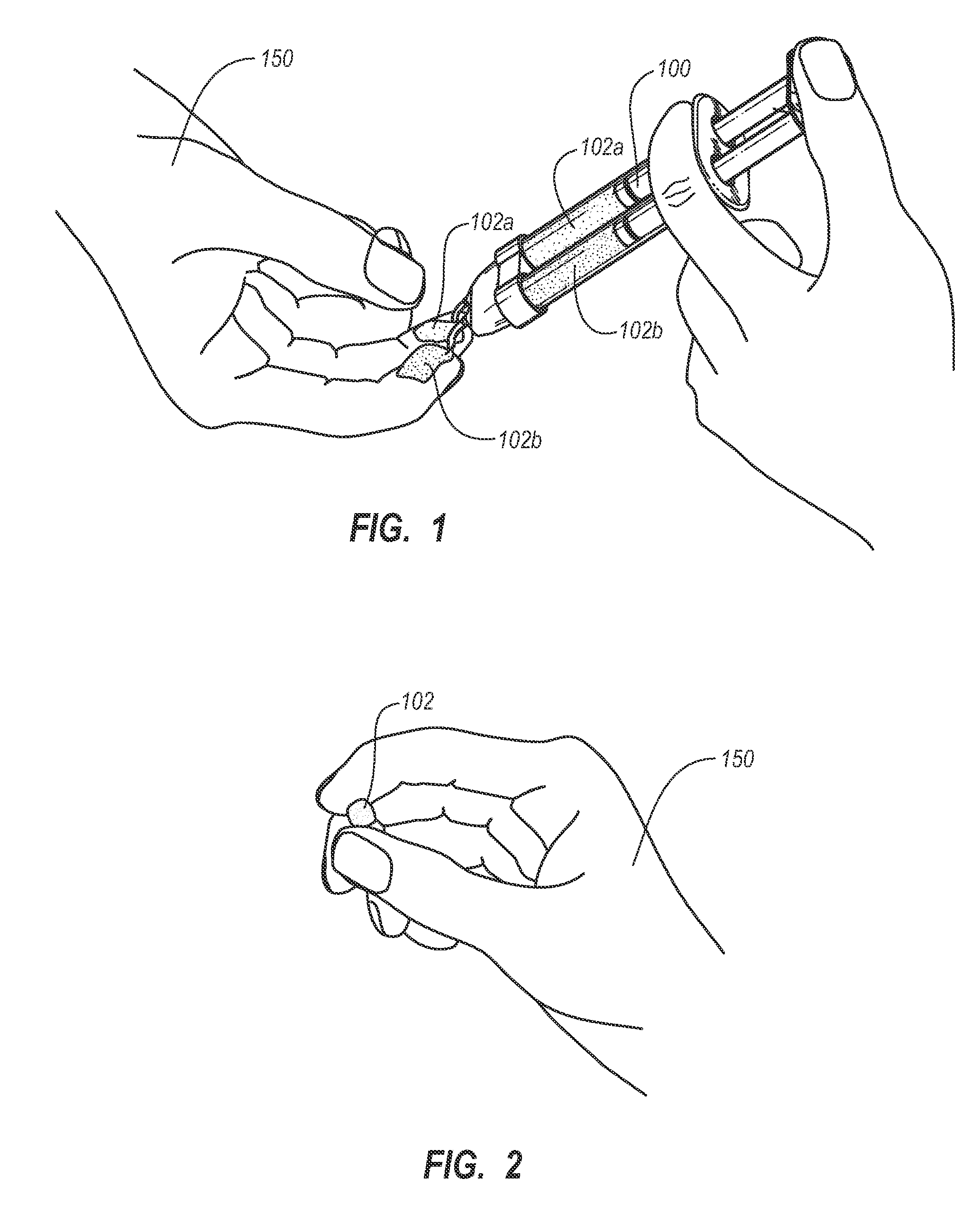Polymerizable temporary coating methods and systems for intraoral devices
a technology of intraoral devices and temporary coatings, applied in the field of intraoral device systems, can solve the problems of affecting the healing effect of patients, so as to reduce the discomfort of soft tissues and high viscosity
- Summary
- Abstract
- Description
- Claims
- Application Information
AI Technical Summary
Benefits of technology
Problems solved by technology
Method used
Image
Examples
example 1
[0040]An exemplary two part silicone composition was formed from the following components. All percentages are by weight, unless specified otherwise.
Part OneDMS (MW 28,000)50.0%Methylhydrosiloxane dimethylsiloxane cross-linker (MW 3500)6.0%Silanated 0.7 micron glass filler37.5%Silanated nano silicone filler5.5%Glycerin1.0%Part TwoDMS (MW 28,000)50.0%Silanated 0.7 micron glass filler42.9%Silanated nano silicone filler6.0%Glycerin1.0%Platinum-divinyltetramethylsiloxane complex0.1%
[0041]The two parts were of relatively high viscosity so as to have a putty like consistency and were kneaded and rolled together for about 30 seconds so as to effect mixing of the two parts. The mixed composition was applied over a labial surface of a selected orthodontic bracket bonded to a tooth before polymerization was complete, and was shaped and molded to a desired shape and coverage of the bracket. The composition completed polymerization within about 80 seconds after initial mixing, which polymerizat...
example 2
[0042]An exemplary two part silicone composition is formed from the following components. All percentages are by weight, unless specified otherwise.
Part OneDMS (MW 28,000)50.0% Methylhydrosiloxane dimethylsiloxane cross-linker6.0%Silanated 0.7 micron glass filler37.5% Silanated nano silicone filler5.5%Glycerin1.0%Part TwoDMS (MW 28,000)50.0% Silanated 0.7 micron glass filler40.9% Silanated nano silicone filler6.0%Glycerin1.0%Platinum-divinyltetramethylsiloxane complex0.1%Bubblegum flavor 2%
[0043]The two parts are of relatively high viscosity so as to have a putty like consistency and are kneaded and rolled together for about 30 seconds so as to effect mixing of the two parts. The mixed composition is applied over a labial surface of a selected orthodontic bracket bonded to a tooth before polymerization is complete, and is shaped and manipulated to a desired shape and coverage of the bracket. The composition completes polymerization within about 80 seconds after initial mixing, whic...
example 3
[0044]An exemplary two part silicone composition is formed from the following components. All percentages are by weight, unless specified otherwise.
Part OneDMS (MW 28,000)50.0%Methylhydrosiloxane dimethylsiloxane cross-linker6.0%Silanated 0.7 micron glass filler37.5%Silanated nano silicone filler5.5%Glycerin1.0%Part TwoDMS (MW 28,000)50.0%Silanated 0.7 micron glass filler42.4%Silanated nano silicone filler6.0%Glycerin1.0%Platinum-divinyltetramethylsiloxane complex0.1%Bubblegum flavor0.5%
[0045]The two parts are of relatively high viscosity so as to have a putty like consistency and are kneaded and rolled together for about 30 seconds so as to effect mixing of the two parts. The mixed composition is applied over a labial surface of a selected orthodontic bracket bonded to a tooth before polymerization is complete, and is shaped and manipulated to a desired shape and coverage of the bracket. The composition completes polymerization within about 80 seconds after initial mixing, which po...
PUM
 Login to View More
Login to View More Abstract
Description
Claims
Application Information
 Login to View More
Login to View More - R&D
- Intellectual Property
- Life Sciences
- Materials
- Tech Scout
- Unparalleled Data Quality
- Higher Quality Content
- 60% Fewer Hallucinations
Browse by: Latest US Patents, China's latest patents, Technical Efficacy Thesaurus, Application Domain, Technology Topic, Popular Technical Reports.
© 2025 PatSnap. All rights reserved.Legal|Privacy policy|Modern Slavery Act Transparency Statement|Sitemap|About US| Contact US: help@patsnap.com



